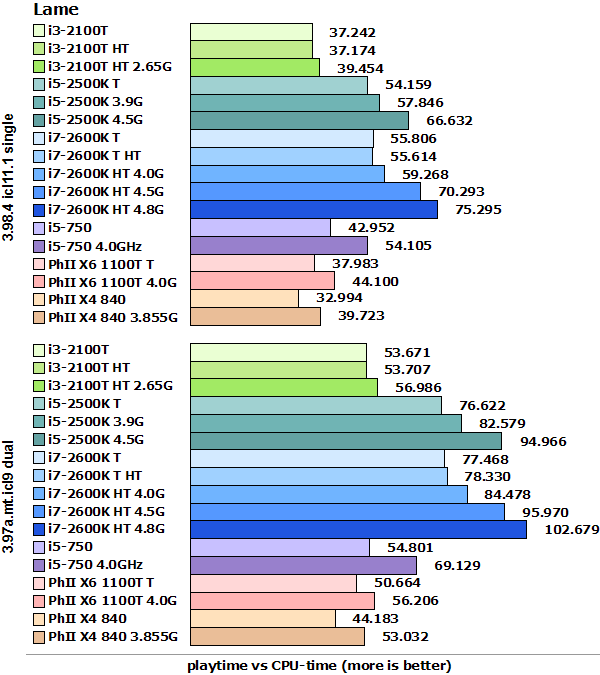Index
Page 5 of 7
Benchmarks:
All benchmarks are 64bit applications. We deviated from the benchmarks by using more cpu-intensive applications, so we hope WinRAR and TrueCrypt will give you a better idea. All benches with AVX optimizations show a rather dramatically improve of performance especially compared to its predecessor or AMD. TrueCrypt also supports AES-NI, but Intel has fused off these extensions on the 2100T which hurt the CPU dramatically but at least you get the new AVX instruction set.
CineBench R11.5:
As you can see, AVX support does show.
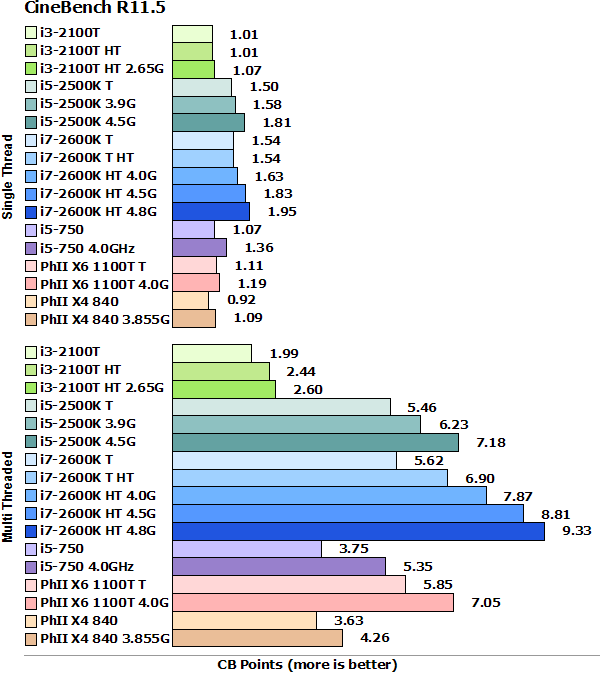
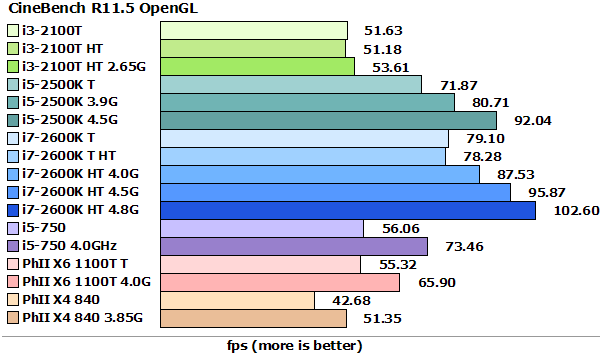
Farcry2:
We stayed with the FarCry2 Benchmark, but now with DX10. As you can see even with 1920x1080 and ultrahigh settings, the GPU reaches its limit and there is almost no difference between stock speeds on a i7-2600K and 4.8GHz. Still, even a 2100T offers very playable framerates but the same is valid for the L3 cacheless quad core AMD Phenom X4 840.
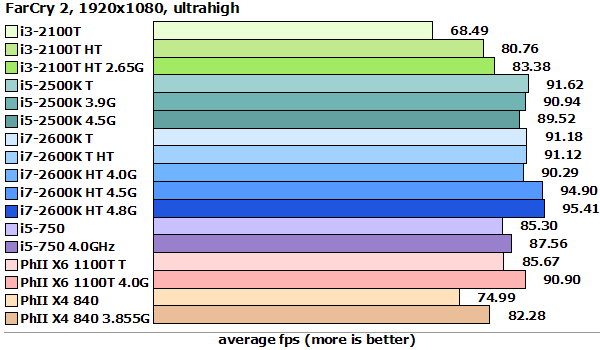
x264:
As usual Hyperthreading does hurt performance with a CPU with four cores and HT enabled in the first pass. In the second pass HT does help and HT enabled/disabled reach nearly the same results. If you have a batch to encode, we would recommend to disable HT for the first pass and after finishing, enable HT and do all second passes. In our slow test we use a GPU filter, which runs completely inside the graphics card and loads our 6870 with about 50%. A faster card may gain you some fps but the 6870 was sufficient. We stayed with our Babylon 5 DVD episode and will list the settings we used. For these benches, we used build 1913 of x264 64-bit edition but increased the bitrate to 1220Mbps. Of course encoding 720p or 1080p material will slow down the encoding considerably - 720p will be about 45% while 1080p would end up with about 16.6% speed of the DVD encoding. We ran this bench three times and used the fastest result.
fast.avs:
# PLUGINS
LoadPlugin("C:\Program Files (x86)\AviSynth 2.5\plugins64\DGDecode.dll")
LoadPlugin("C:\Program Files (x86)\AviSynth 2.5\plugins64\LeakKernelDeint.dll")
# SOURCE
MPEG2Source("D:\work\b5_64bit.d2v")
# FILTERS
LeakKernelDeint(order=1)
fast encode:
x264_x64_1913 --pass 1 --bitrate 1220 --stats "D:\work\b5_x64_fast.stats" --quiet --profile high --preset fast --tune film --bframes 16 --b-pyramid strict --direct auto --sar 16:11 --threads 4 --thread-input --frames 62932 --output NUL "D:\work\B5_x64_4_fast.avs"
x264_x64_1913 --pass 2 --bitrate 1220 --stats "D:\work\b5_x64_fast.stats" --quiet --profile high --preset fast --tune film --bframes 16 --b-pyramid strict --direct auto --sar 16:11 --threads 4 --thread-input --frames 62932 --output "D:\work\B5-x264-fast.mp4" "D:\work\B5_x64_4_fast.avs"
slow.avs:
# PLUGINS
LoadPlugin("C:\Program Files (x86)\AviSynth 2.5\plugins64\DGDecode.dll")
LoadPlugin("C:\Program Files (x86)\AviSynth 2.5\plugins64\Undot.dll")
LoadPlugin("C:\Program Files (x86)\AviSynth 2.5\plugins64\FFT3DGPU.dll")
LoadCPlugin("C:\Program Files (x86)\AviSynth 2.5\plugins64\Yadif.dll")
LoadPlugin("C:\Program Files (x86)\AviSynth 2.5\plugins64\TIVTC.dll")
# SOURCE
MPEG2Source("D:\work\b5_64bit.d2v")
# FILTERS
tfm(d2v="D:\work\b5_64bit.d2v")
MT("Yadif(mode=0,order=1)",4,4)
MT("Undot()",4,4)
FFT3DGPU(bt=4,sigma=2,precision=2,mode=2,bw=48,bh=48)
slow encode:
x264_x64_1913 --pass 1 --bitrate 1220 --stats "D:\work\B5-AVC-slow.stats" --quiet --profile high --preset fast --tune film --rc-lookahead 64 --bframes 16 --b-pyramid strict --direct auto --sar 16:11 --threads 4 --thread-input --frames 62932 --output NUL "D:\work\B5_x64_4_slow.avs"
x264_x64_1913 --pass 2 --bitrate 1220 --stats "D:\work\B5-AVC-slow.stats" --quiet --profile high --preset fast --tune film --rc-lookahead 64 --bframes 16 --b-pyramid strict --direct auto --sar 16:11 --threads 4 --thread-input --frames 62932 --output "D:\work\B5-x264-slow.mp4" "D:\work\B5_x64_4_slow.avs"
Even with AVX extensions the i3-2100T can't cope with the L3-cacheless Phenom II X4 which is surprising. With real four cores Intel leads way ahead, but with AMD optimizing the Phenoms aren't that bad either.
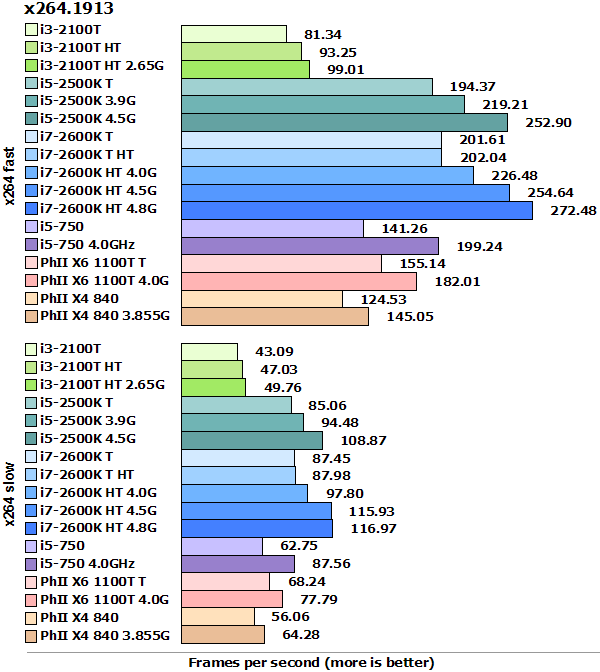
TureCrypt:
TrueCrypt is a very CPU intensive program. It encrypts parts of your HDD and can slow down your HDD performance considerably. With the i5 and higher you have AES-NI extensions which will enable the program to use special instructions for en- and decrypting. We used AES-Twofish, which needs AES and CPU-power. The i3 Series does not offer AES which shows. Even a Phenom II 840 without L3 cache and without AES is nearly twice as fast.
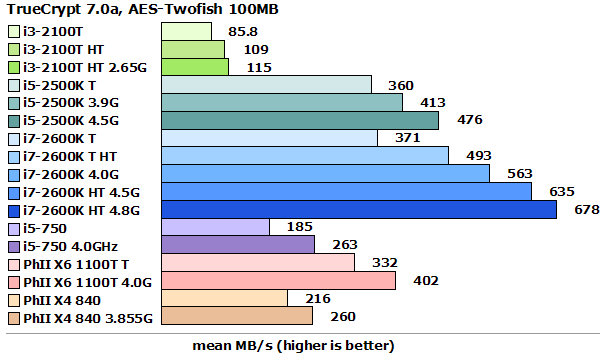
WinRAR:
WinRAR is one of the most popular compression programs and since version 3.90, it supports multi-threading and 64bit. The results seem to indiciate it's optimized for Intel. We used various files, mostly our benches which consist of 6849 files and 408 directories weighing in at 724MB.
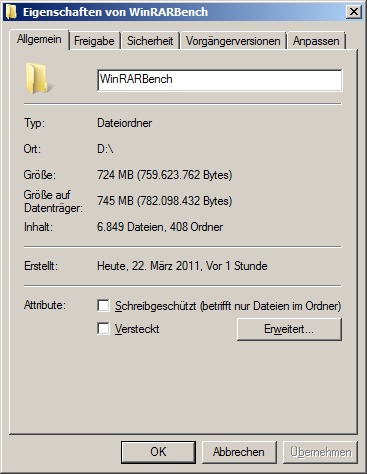
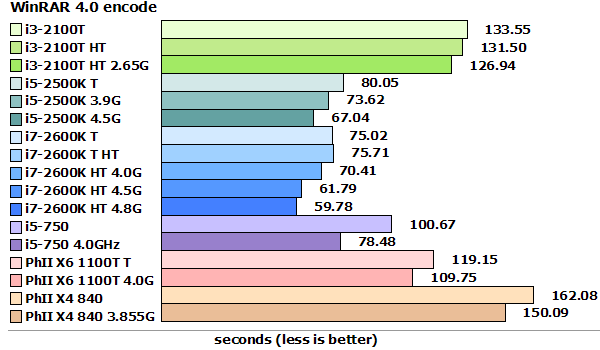
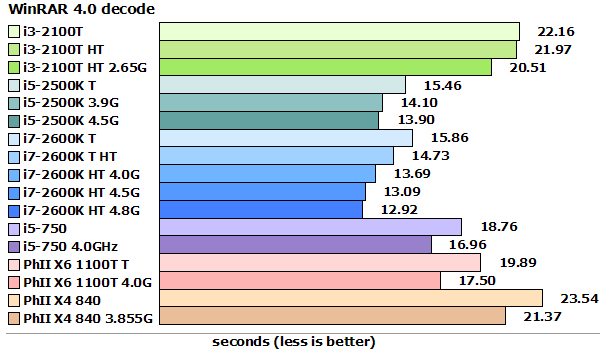
Lame:
We also stayed with LAME, but this time we compared single threaded vs. dual threaded. Unfortunately, there is no encoder which can really do multi-threading encoding. You may encode two, four, six or even eight files in a batch, so one file per core, but it's not the same compared to real multi-threading.
